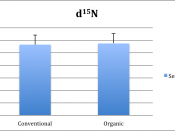Caroline Cuoco
C11260068
The Carbon and Nitrogen Isotope Ratios of Coffee Beans
Introduction.
Hypothesis: Organic coffee beans will have a higher ï¤15N value than conventional coffee beans, while conventional coffee beans will have a higher ï¤13C value than organic coffee beans.
`Rationale: The fertilizers used to grow organic and conventional crops, in this case coffee beans, will result in a difference in the ï¤15N between the different crops (Bateman 2007). In conventional fertilizers ammonium nitrate is the most commonly used nitrogen fertilizer, while in organic fertilizers the most commonly used components are compost, hornmeal, dung and green manure. The components that make up organic fertilizers tend to be more 15N enriched than the ammonium nitrate that composes conventional fertilizer (Bateman 2007). The ï¤13C value will be larger in conventional coffee beans due to the differences in soil respiration between organic and conventional coffee bean trees (Georgi 2005). The methods in which organic systems are managed lead to higher microbial activity in the soil, leading to higher rates of soil respiration, which result in the lowering of ï¤13C values (Georgi 2005).
This corresponds to the lower ï¤13C value expected in in the organic coffee beans.
Materials and Methods.
We selected 8 different types of coffee beans all from different regions, with 4 brands being organic and the other 4 conventional. The coffee beans were ground and tested using mass spectrometry for isotopic abundances. We used an Anova test to help us analyze if there were significant difference in the 15N values and the 13C values between organic and conventional coffee beans. We then did an additional Anova test to see if there were significant differences in the 15N and 13C for the different types of organic coffee beans and the different types of conventional coffee beans. The differences are statistically...

